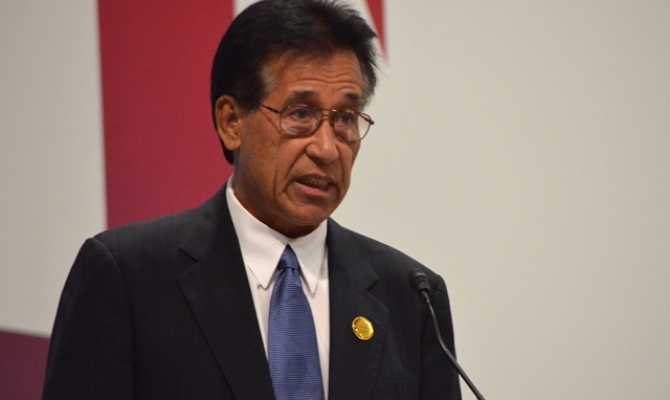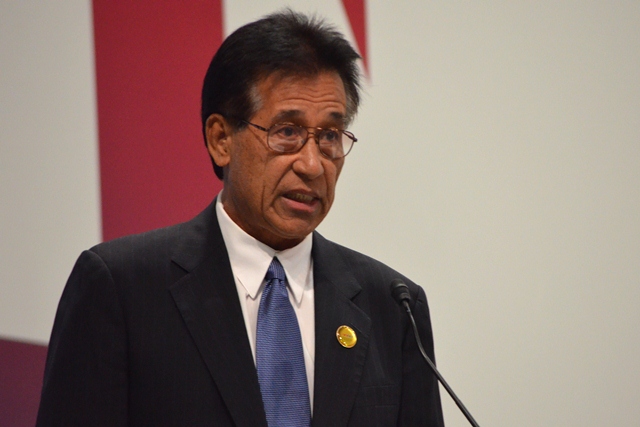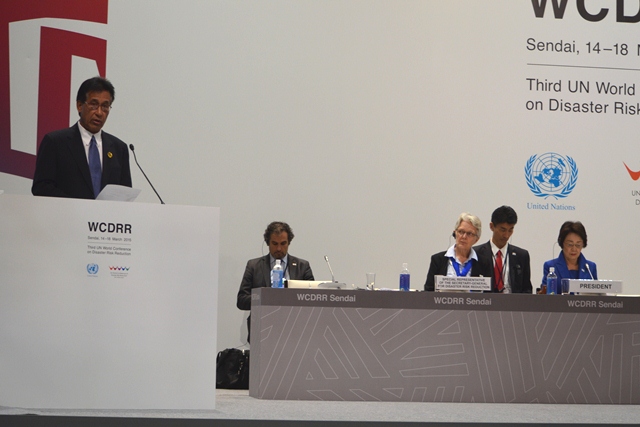
Climate Change Resilience
14 March 2015, Sendai, Japan - Calling upon the world to act to substantially reduce greenhouse gas emissions was the plea from President Emanuel Mori of the Federated States of Micronesia as he spoke from the podium at the third UN world conference on disaster risk reduction today.
 "There is no denying that there is an intertwined link between disasters and climate change," he stated.
"There is no denying that there is an intertwined link between disasters and climate change," he stated.
"We must stabilise our greenhouse gas emissions within an appropriate time frame and at a level that will reduce risks and protect our islands, and the planet as a whole."
FSM is made up of four states spread across the western Pacific Ocean of which approximately 30 percent of the population lives on 60 low lying and atoll islands.
"For my country, natural disasters and undeterred global warming brought about by human activity will lead to the same thing, whether abruptly or gradually - that is the disappearance of our islands."
"With the frequencies of storms and their intensities exacerbated by climate change, prompt and effective actions are needed to save the vulnerable homelands of my people and indeed those of many more islanders like us."
President Mori stated that Small Island Developing States suffer inherent constraints which seriously disadvantages their ability to advance the global agenda for disaster risk reduction, constraints which also make it difficult to achieve sustainable development and to recover from natural disasters.
"As far as the disaster risk reduction framework is concerned, the responsibility to manage the risk of loss and damage from all kind of disasters is squarely shouldered by national and local stakeholders; the international support system is there but only on a voluntary basis."
"We have not yet adequately developed the internal techniques and capacities required of us. Support has to be given to help us build our capacities."
 President Mori concluded his statement referencing the Small Island Developing States Accelerated Modalities of Action – the SAMOA Pathway adopted at the SIDS conference hosted in Apia, Samoa last year. This document recognises the need to reduce vulnerability and increase preparedness in SIDS.
President Mori concluded his statement referencing the Small Island Developing States Accelerated Modalities of Action – the SAMOA Pathway adopted at the SIDS conference hosted in Apia, Samoa last year. This document recognises the need to reduce vulnerability and increase preparedness in SIDS.
"The Pathway must be mainstreamed into the Disaster Risk Reduction Framework and into the post-2015 development agenda in order to ensure that the realities that SIDS face are firmly embedded into the outcomes of these processes.
"In conclusion, I wish to express Micronesia's commitment and support to the outcome of this conference."
The Third UN World Conference on Disaster Risk Reduction is hosted in Sendai, Japan from 14 - 18 March.
The Secretariat of the Pacific Regional Environment Programme is attending the 3WCDRR partnering with the UNISDR, Pacific Islands Forum Secretariat, Secretariat of the Pacific Community and the University of the South Pacific together with Pacific Island Countries and Territories to raise awareness of the Integrated Strategy for Climate and Disaster Resilient Development in the Pacific (SRDP). New Caledonia is also attending this 3WCDRR. The Pacific island region is the first to bring together climate change and disaster risk reduction in an overarching framework.

"We must stabilise our greenhouse gas emissions within an appropriate time frame and at a level that will reduce risks and protect our islands, and the planet as a whole."
FSM is made up of four states spread across the western Pacific Ocean of which approximately 30 percent of the population lives on 60 low lying and atoll islands.
"For my country, natural disasters and undeterred global warming brought about by human activity will lead to the same thing, whether abruptly or gradually - that is the disappearance of our islands."
"With the frequencies of storms and their intensities exacerbated by climate change, prompt and effective actions are needed to save the vulnerable homelands of my people and indeed those of many more islanders like us."
President Mori stated that Small Island Developing States suffer inherent constraints which seriously disadvantages their ability to advance the global agenda for disaster risk reduction, constraints which also make it difficult to achieve sustainable development and to recover from natural disasters.
"As far as the disaster risk reduction framework is concerned, the responsibility to manage the risk of loss and damage from all kind of disasters is squarely shouldered by national and local stakeholders; the international support system is there but only on a voluntary basis."
"We have not yet adequately developed the internal techniques and capacities required of us. Support has to be given to help us build our capacities."

"The Pathway must be mainstreamed into the Disaster Risk Reduction Framework and into the post-2015 development agenda in order to ensure that the realities that SIDS face are firmly embedded into the outcomes of these processes.
"In conclusion, I wish to express Micronesia's commitment and support to the outcome of this conference."
The Third UN World Conference on Disaster Risk Reduction is hosted in Sendai, Japan from 14 - 18 March.
The Secretariat of the Pacific Regional Environment Programme is attending the 3WCDRR partnering with the UNISDR, Pacific Islands Forum Secretariat, Secretariat of the Pacific Community and the University of the South Pacific together with Pacific Island Countries and Territories to raise awareness of the Integrated Strategy for Climate and Disaster Resilient Development in the Pacific (SRDP). New Caledonia is also attending this 3WCDRR. The Pacific island region is the first to bring together climate change and disaster risk reduction in an overarching framework.